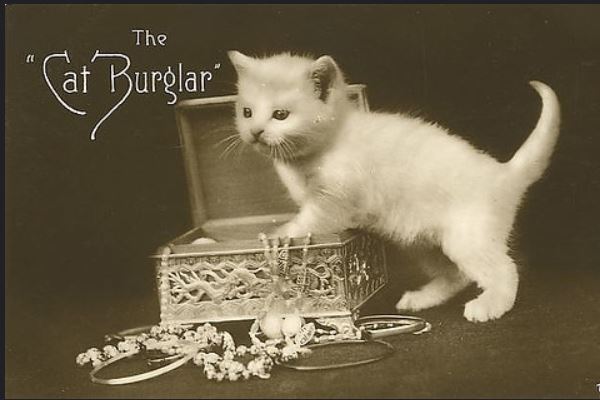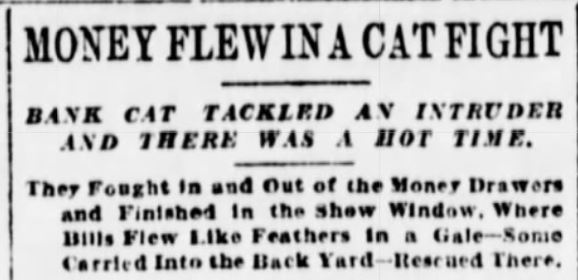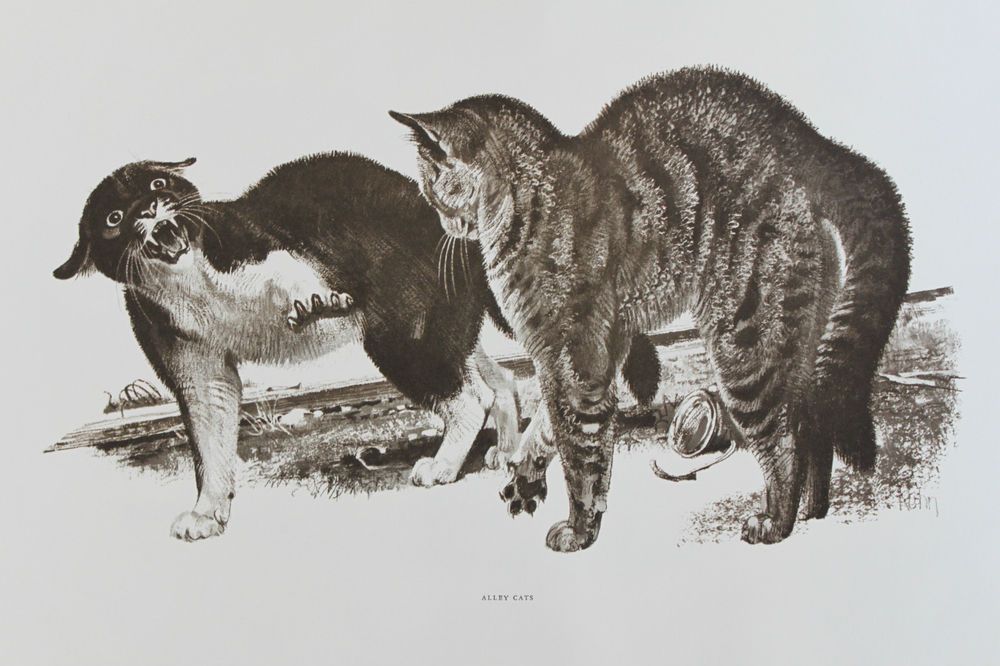
Don’t mess with Isaac the bank cat. And don’t even think about coming in and stealing his territory–or the cash, for that matter.
That was the message a “gaunt hobo cat” received when he sauntered into the Louis Scharlach & Co. bank at 362 Grand Street on the Lower East Side on November 14, 1900.
According to an article in the New York Sun, the feline interloper walked into the bank during business hours and somehow managed to sneak by all the human clerks without notice. He crawled under a safe and settled in for a warm nap. As the reporter noted, what happened next “caused more excitement…then there had been on the Lower East Side since election night.”

Everything was peaceful until Isaac, described as “the well-fed office cat,” sensed the presence of the would-be cat burglar and started sniffing him out. It wasn’t long before Isaac found the intruder under the safe and began lashing out with his claws. According to The Sun, “Both animals were abusing each other in the worst language cats can command, and the fur on Isaac’s back was standing straight up.”
Bank clerk Max Lubiner made an amateur mistake by thinking he could also reach under the safe and grab the unwanted guest. When the cat sank his claws into Max’s hand, the clerk howled out in agony.
Several other clerks were able to coax out the cat using sticks, but that only made matters worse. Once the two felines were free from the metal safe, “there was the wildest kind of a time in the bank.” The cats went full at it, jumping on desks and scattering piles of paper money and coins that the clerks had been counting for customers.

“Lock the door! Lock the door!” Lubiner screamed. (Another amateur mistake. One should never scream “Fire!” in a theater or yell “Lock the door!” in a bank.) Bank depositors and clerks alike went into full panic mode, thinking there was a robbery in progress. Cat burglary, yes, but not a robbery.
While clerks continued chasing the cats with brooms and umbrellas, the cats scampered over desks and wide-open money drawers, sending gold and silver coins to the floor. The guant hobo cat was thin and springy enough to elude capture. And there was no restraining Isaac, who was twice the size of his opponent. Many of the clerks gave up the cat fight and decided to save the money instead.

The cat burglar made his way into a front showroom window, where there were spread out bills of all denominations. Isaac cornered his enemy, who appeared to be making his last stand. For several more minutes, the cats battled it out on the greenbacks while a crowd of people gathered outside with hopes that the window would smash open and send the money into the street.
The hobo cat eventually freed himself and ran toward an open window at the rear of the bank. As he started to jump out the window, a few clerks noticed that there was money attached to his claws.
Fortunately, the rear yard was surrounded by a tall fence, so all he could do was hide inside a large barrel. The clerks were able to throw a cloth over him and retrieve the stolen money. Once again, thought, the cat burglar eluded the clerks by jumping back inside the bank.
Naturally, while all the fur (and cash) was flying, so too were the rumors. Within a few minutes, a crowd standing outside by the rear yard were convinced that a human burglar was trying to rob the bank and was struggling with the clerks in the yard. Someone summoned Bicycle Policeman Selig Ajax Whitman of the nearby Eldridge Street police station.

When Policeman Whitman–aka Ajax the Strong Man–arrived on the scene, he pounded on the locked front door. When the clerks opened the door, the hobo cat made a beeline for the escape route and ran out as fast as he could.

“Where are the thieves? Whitman asked while grabbing his club and preparing to strong-arm the bad guys.
“There he goes,” one of the clerks replied, pointing to the small cat running toward the Bowery.
“Oh hell,” Whitman responded, clearly embarrassed by the whole situation.
That afternoon, the clerks all had to work overtime in order to gather up the money and recount it. They said that all of the money was accounted for, but I have hopes that the hobo cat snuck away with at least a few coins in his claws to buy himself a nice piece of fish and bowl of milk from the nearby Essex Market.






Poor Hobo Cat! All that fuss and not a thing to show for his troubles in the end. Isaac did his job, thus can’t be blamed, but the bank personnel sound like idiots. Had NONE of them ever seen or owned a cat? Reaching for a strange cat that’s already trying to defend itself from attack in the midst of a territorial face-off is, frankly, suicidal behavior. And leaving bank drawers open while the fray is in full swing? Utter dopes that deserved the aftermath.
I hope Hobo Cat eventually found a warm and safe place to sleep, as well as a kind person to feed and house him. As for the bank, I suspect “advanced security measures” were instituted shortly thereafter.
Sadly, most people during this time period were very unkind to cats, dogs, and other animals. They also had no clue on how to properly take care of them. Isaac won the lottery, in that he was one of thousands of cats born in the city every year that had a fairly good home. The men were not experts in cat care, but they at least provided him with shelter and food. I also hope the hobo cat found a warm home. The one good thing was that he lived near the Essex Market, so perhaps he found food and shelter there.